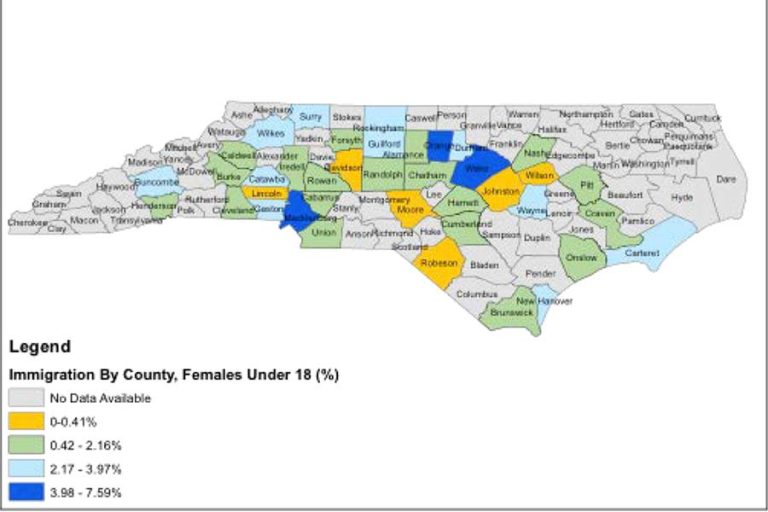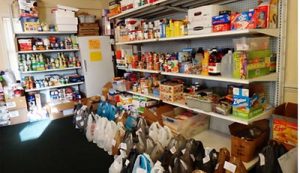THE STATUS
OF GIRLS IN
NORTH CAROLINA
Contact Information
General Information:
Amie Hess
(919) 760-8016
hessamie@meredith.edu
Press Contact:
Melyssa Allen, News Director
(919) 760-8455
allenme@meredith.edu
Females make up 51.25% of North Carolina’s current population of over 10 million residents.1 The total female population of youth under 18 in North Carolina is 1,116,469, slightly more than 11% of the state’s total population. Females in North Carolina are at great risk for poverty. This is particularly true of single mothers and very young girls.2 Almost half of North Carolina’s children are either low-income or poor.3
Demographics
North Carolina has experienced annual population growth rates averaging almost 2.0% over the last two decades.4 Between 2000 and 2010 North Carolina added almost 1.5 million residents, making it one of the fastest growing states in the country. Our growth has slowed in recent years; in 2014, the population grew by only 0.9%. While some areas of the state are seeing a lot of growth, other areas are experiencing population losses. Growth has primarily been concentrated in the metropolitan areas of the state. Over half of all rural counties have experienced population loss. In contrast, the Raleigh-Cary area ranks as the fifteenth fastest growing metropolitan statistical area (MSA) in the country.5 While the state is experiencing overall population growth, the racial/ ethnic makeup of the girls who call North Carolina home continues a long-term trend of changing demographics.
North Carolina’s shifting demographics are particularly noticeable among the youngest girls in the state. The share of girls in North Carolina of Latina origin and those identifying as multiracial is growing, while the percentage of both white and African American girls in North Carolina is declining. These trends have remained relatively consistent since 2010.
Sources: U.S. Census Bureau, American Community Survey, 2015; U.S. Census Bureau, American Community Survey, 2010
Immigration Status
Only 8% of North Carolina’s population is foreign born. Ninety-seven percent of girls under 18 in North Carolina and 91% of women 18 and over are native born. Among the counties with available data, Orange County has the largest proportion of foreign-born girls under 18 at slightly over 7.5%. Of those young women, 1.21% are naturalized citizens, while 6.38% are non-citizens. North Carolina’s female immigrant population is primarily clustered in the central (Piedmont) region.
Figure 3. Percentage of immigration among females under 18, by county

Source: U.S. Census Bureau, American Community Survey, 2015
Nationally, immigration rates have declined. This is true in North Carolina as well. In 2010 five counties had populations of foreign-born girls that exceeded 5%. In 2015, there were only two.6
Family Demographics
North Carolina’s children are growing up today in a variety of family configurations. At present, data is difficult to find on all the possible configurations that exist.7 The information available shows that the majority of children are growing up in homes with two married parents, but those numbers have declined since 2000.8 Children in North Carolina are more likely to grow up in a single parent household now than they were fifteen years ago.
Sources: U.S. Census Bureau, American Community Survey, 2015; U.S. Census Bureau, American Community Survey; 2010; U.S. Census, 2000.
The percentage of children in North Carolina living with single parents, particularly single mothers, has increased while the percentage of children living within a two-parent married family declined between 2000 and 2015. There is a small, but increasing, number of children growing up in homes with same-sex parents. Researchers estimate that approximately 18.5% of the over 18,000 same-sex couples in North Carolina are raising children. Approximately 2.6% of children in North Carolina are living with same-sex couples.9
Child Poverty
North Carolina, like the rest of the nation, continues steady economic growth as we near a decade post- recession. Despite this economic improvement, the state’s economic recovery has been uneven. The rate of both economic growth and unemployment vary regionally and by population group.10 Data on the economic security of North Carolina’s girls and young women shows that while the poverty rate has stabilized after years of growth, the poverty rate of the youngest girls and the severe economic struggles of families headed by women remain troubling. According to the current federal poverty guidelines, a child is considered poor if she lives in a family of four whose income falls below $24,250.11 Poverty experts agree that it takes an income at least twice the federal poverty line for a family to survive and cover key expenses.12
Nationally, about 21% of children live in poverty while approximately 44% are considered low-income (defined as twice the poverty line).13 Twenty-three percent of North Carolina’s children are poor.14 North Carolina has the 14th highest rate of child poverty nationally and saw an increase of approximately 5% in the number of poor children between 2000 and 2015.15 An additional 30% of the state’s children are living in low-income families in which at least one parent is working.16 Approximately half of the state’s children are in or near poverty.
Source: U.S. Census Bureau, American Community Survey, 2015
Poverty rates among North Carolina’s girls are high, but not all girls are equally at risk for living in poverty. First, non-white girls, with the notable exception of those of Asian descent, are at far greater risk of living in poverty when compared to their white counterparts. This pattern holds at all ages. Second, while the youngest girls—those under 5 years old—were most likely to be poor across racial and ethnic categories in 2010, in 2015, this is only true for African American, Latina, and multiracial girls. Among white, Asian, and American Indian or Alaskan Native girls, the oldest girls—those from 18 to 24—are more likely to be poor.
Source: U.S. Census Bureau, American Community Survey, 2015
In the same way that the relative risk of a girl living in poverty differs by her age and racial/ethnic status, it also differs by family type. While the median income for families in North Carolina is $60,074, that average hides quite a bit of disparity.17 For example, among families headed by a single mother, the average annual income is just slightly under $23,000.18 The gap between the median family income for all families with children and for families headed by a single mother has increased since 2010. This means that children growing up in with a single mother are very likely to be poor or low-income. In 2015, families headed by women make up 27% of families in North Carolina and almost 49% of those families lived below the poverty line.19
Cause for Concern
Residents should celebrate the increasing diversity among the girls in North Carolina. However, the increased likelihood of poverty among non-white girls and their families is troubling. The rate of poverty in families head ed by a lone woman (single-mother) and the growing gap between the incomes of different family types are also troubling trends. All families must be supported with adequate wages and affordable, high-quality childcare.
Spotlight Organization: Our Lady of the Rosary Food Pantry
 Our Lady of the Rosary Food Pantry is based in Franklin County, NC. It is a branch of the Our Lady of the Rosary Catholic Church, but religious affiliation is not taken into consideration when providing services. Though most of its clients are located in Franklin County, the pantry provides relief for people from surrounding counties as well. The pantry engages in significant outreach to the local immigrant population. One of the group’s largest projects is providing food and necessities to seasonal farmworkers. This specific population is in much need of support because their employment requires them to travel from place to place to work in agriculture and move into temporary housing while working. Likewise, more than a food pantry, this organization provides clothes to impoverished families and tutoring services for Spanish-speaking children. During the holidays, the pantry also provides turkeys and presents for the children of these families.
Our Lady of the Rosary Food Pantry is based in Franklin County, NC. It is a branch of the Our Lady of the Rosary Catholic Church, but religious affiliation is not taken into consideration when providing services. Though most of its clients are located in Franklin County, the pantry provides relief for people from surrounding counties as well. The pantry engages in significant outreach to the local immigrant population. One of the group’s largest projects is providing food and necessities to seasonal farmworkers. This specific population is in much need of support because their employment requires them to travel from place to place to work in agriculture and move into temporary housing while working. Likewise, more than a food pantry, this organization provides clothes to impoverished families and tutoring services for Spanish-speaking children. During the holidays, the pantry also provides turkeys and presents for the children of these families.
Notes and References
1 U.S. Census Bureau, Population Estimates, 2014.
2 U.S. Census Bureau, American Community Survey, 2015.
3 Annie E. Casey Foundation. 2015. Kids Count Data Center. See: http://datacenter.kidscount.org.
4 North Carolina Office of Budget and Management, Municipal Estimates, 2015.
5 U.S. Census Bureau, Population Estimates, 2014.
6 U.S. Census Bureau, American Community Survey, 2015.


